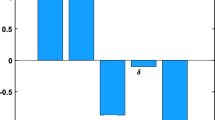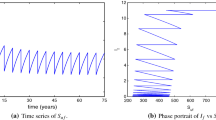Abstract
In this article, a fractional order Human papillomavirus infection model with the impact of vaccination is presented with Caputo sense. The basic properties of the model are investigated. Using the fixed point theorem, the existence and uniqueness of the solution for the proposed Caputo fractional order HPV model have been proved. Theoretical results are validated by solving the proposed model using the Adams-Bashforth-Moulton Predictor corrector scheme. The numerical result reveals that HPV infection can be reduced by implementing vaccination as a control strategy. Moreover, simulation results indicated that the qualitative nature of the solutions of the classical integer order and the fractional-order model are the same.




Similar content being viewed by others
Data availability
The data that support the findings of this study are included within the article.
References
Crow, J.M. 2012. HPV: The global burden. Nature 488 (7413): 2–3. https://doi.org/10.1038/488S2a.
Alsaleh, A.A., and A.B. Gumel. 2014. Dynamics analysis of a vaccination model for HPV transmission. J. Biol. Systems 22 (4): 555–599. https://doi.org/10.1142/S0218339014500211.
Insinga, R.P., E.J. Dasbach, and E.H. Elbasha. 2009. Epidemiologic natural history and clinical management of human papillomavirus (HPV) disease: a critical and systematic review of the literature in the development of an HPV dynamic transmission model. BMC infectious diseases 9 (1): 1–26. https://doi.org/10.1186/1471-2334-9-119.
Burd, E.M. 2003. Human papillomavirus and cervical cancer. Clinical microbiology reviews 16 (1): 1–17. https://doi.org/10.1128/CMR.16.1.1-17.2003.
Lowy, D.R., and J.T. Schiller. 2006. Prophylactic human papillomavirus vaccines. The Journal of clinical investigation 116 (5): 1167–1173. https://doi.org/10.1172/JCI28607.
Chaturvedi, A.K. 2010. Beyond cervical cancer: burden of other HPV-related cancers among men and women. Journal of adolescent health 46 (4): 20–26. https://doi.org/10.1016/j.jadohealth.2010.01.016.
Schlipköter, U., and A. Flahault. 2010. Communicable diseases: achievements and challenges for public health. Public Health Reviews 32: 90–119. https://doi.org/10.1007/BF03391594.
Brinth, L., A.C. Theibel, K. Pors, and J. Mehlsen. 2015. Suspected side effects to the quadrivalent human papilloma vaccine. Dan Med J 62 (4): 5064.
McLaughlin-Drubin, M.E., and C. Meyers. 2004. Evidence for the coexistence of two genital hpv types within the same host cell in vitro. Virology 321 (2): 173–180. https://doi.org/10.1016/j.virol.2003.12.019.
Mori, S., R. Kusumoto-Matsuo, Y. Ishii, T. Takeuchi, and I. Kukimoto. 2014. Replication interference between human papillomavirus types 16 and 18 mediated by heterologous e1 helicases. Virology Journal 11 (1): 1–12. https://doi.org/10.1186/1743-422X-11-11.
Chakraborty, S., J. Pal, S. Chowdhury, and P.K. Roy. 2017. The impact of vaccination to control human papillomavirus dynamics. Industrial Mathematics and Complex Systems: Emerging Mathematical Models, Methods and Algorithms 237–247. https://doi.org/10.1007/978-981-10-3758-0_16.
Zhang, J., and K. Wang. 2022. Mathematical modeling and computational prediction of high-risk types of human papillomaviruses. Computational and Mathematical Methods in Medicine 2022. https://doi.org/10.1155/2022/1515810.
Lee, S.L., and A.M. Tameru. 2012. A mathematical model of human papillomavirus (HPV) in the United states and its impact on cervical cancer. Journal of Cancer 3: 262. https://doi.org/10.7150/jca.4161.
Villanueva, R.-J., V. Sánchez-Alonso, and L. Acedo. 2022. A mathematical model for human papillomavirus vaccination strategies in a random network. Mathematical Methods in the Applied Sciences 45 (6): 3284–3294. https://doi.org/10.1002/mma.7205.
Rajan, P.K., M. Kuppusamy, and O.F. Egbelowo. 2023. A mathematical model for human papillomavirus and its impact on cervical cancer in India. J. Appl. Math. Comput. 69 (1): 753–770. https://doi.org/10.1007/s12190-022-01767-2.
Liu, G., N.R. Mugo, C. Bayer, D.W. Rao, M. Onono, N.M. Mgodi, Z.M. Chirenje, B.W. Njoroge, N. Tan, E.A. Bukusi, and R.V. Barnabas. 2022. Impact of catch-up human papillomavirus vaccination on cervical cancer incidence in Kenya: A mathematical modeling evaluation of HPV vaccination strategies in the context of moderate HIV prevalence. EClinicalMedicine 45: 101306. https://doi.org/10.1016/j.eclinm.2022.101306.
Al-arydah, M., and R. Smith. 2011. An age-structured model of human papillomavirus vaccination. Mathematics and Computers in Simulation 82 (4): 629–652. https://doi.org/10.1016/j.matcom.2011.10.006.
Choi, Y.H., M. Jit, N. Gay, A. Cox, G.P. Garnett, and W.J. Edmunds. 2010. Transmission dynamic modelling of the impact of human papillomavirus vaccination in the United Kingdom. Vaccine 28 (24): 4091–4102. https://doi.org/10.1016/j.vaccine.2009.09.125.
Johnson, H.C., E.I. Lafferty, R.M. Eggo, K. Louie, K. Soldan, J. Waller, and W.J. Edmunds. 2018. Effect of HPV vaccination and cervical cancer screening in england by ethnicity: a modelling study. The Lancet Public Health 3 (1): 44–51. https://doi.org/10.1016/S2468-2667(17)30238-4.
Kilbas, A.A., H.M. Srivastava, J.J. Trujillo. 2006. Theory and Applications of Fractional Differential Equations. North-Holland Mathematics Studies, vol. 204, Elsevier Science B.V., Amsterdam. p. 523.
Samko, S.G., A.A. Kilbas, and O.I. Marichev. 1993. Fractional Integrals and Derivatives: Theory and Applications, 976. Yverdon: Gordon and Breach Science Publishers.
Podlubny, I. 1999. Fractional Differential Equations. Mathematics in Science and Engineering, vol. 198, p. 340. Academic Press, Inc., San Diego, CA
Yusuf, A., B. Acay, U.T. Mustapha, M. Inc, and D. Baleanu. 2021. Mathematical modeling of pine wilt disease with Caputo fractional operator. Chaos Solitons Fractals 143: 110569–13. https://doi.org/10.1016/j.chaos.2020.110569.
Khan, M.A., A. Khan, A. Elsonbaty, and A.A. Elsadany. 2019. Modeling and simulation results of a fractional dengue model. Eur. Phys. J. Plus 134: 379. https://doi.org/10.1140/epjp/i2019-12765-0.
Baba, I.A., and B. Ghanbari. 2019. Existence and uniqueness of solution of a fractional order tuberculosis model. Eur. Phys. J. Plus 134: 489. https://doi.org/10.1140/epjp/i2019-13009-1.
Simelane, S., and P. Dlamini. 2021. A fractional order differential equation model for hepatitis B virus with saturated incidence. Results in Physics 24: 104114. https://doi.org/10.1016/j.rinp.2021.104114.
Khan, F.M., A. Ali, and Z.U. Khan. 2022. On existence and semi-analytical results to fractional order mathematical model of COVID-19. Arab Journal of Basic and Applied Sciences 29 (1): 40–52. https://doi.org/10.1080/25765299.2022.2037843.
Hussain, A., D. Baleanu, and M. Adeel. 2020. Existence of solution and stability for the fractional order novel coronavirus (ncov-2019) model. Adv Differ Equ 2020: 384. https://doi.org/10.1186/s13662-020-02845-0.
Odibat, Z.M., and N.T. Shawagfeh. 2007. Generalized Taylor’s formula. Appl. Math. Comput. 186 (1). https://doi.org/10.1016/j.amc.2006.07.102.
Diekmann, O., J.A.P. Heesterbeek, and J.A.J. Metz. 1990. On the definition and the computation of the basic reproduction ratio \(R_0\) in models for infectious diseases in heterogeneous populations. J. Math. Biol. 28 (4): 365–382. https://doi.org/10.1007/BF00178324.
Van den Driessche, P., and J. Watmough. 2002. Reproduction numbers and sub-threshold endemic equilibria for compartmental models of disease transmission. Math. Biosci. 180: 29–48. https://doi.org/10.1016/S0025-5564(02)00108-6. John A. Jacquez memorial volume.
Zafar, Z.U.A., M.T. Hussain, M. Inc, D. Baleanu, B. Almohsen, A.S. Oke, and S. Javeed. 2022. Fractional-order dynamics of human papillomavirus. Results in Physics 34: 105281. https://doi.org/10.1016/j.rinp.2022.105281.
Carvalho, A.R.M., and C.M.A. Pinto. 2018. Non-integer order analysis of the impact of diabetes and resistant strains in a model for TB infection. Commun. Nonlinear Sci. Numer. Simul. 61: 104–126. https://doi.org/10.1016/j.cnsns.2018.01.012.
Diethelm, K., N.J. Ford, and A.D. Freed, 2002. A predictor-corrector approach for the numerical solution of fractional differential equations. vol. 29, pp. 3–22. https://doi.org/10.1023/A:1016592219341. Fractional order calculus and its applications.
Acknowledgements
The research work of the First author Mr. R. Praveen Kumar is suppoted by INSPIRE Fellowship (IF180053), Department of Science and Technology, Govt of India.
Author information
Authors and Affiliations
Contributions
Praveen Kumar Rajan: Conceptualization, Methodology, Software, Formal analysis, Writing- Original draft preparation, Writing-Reviewing and Editing. Murugesan Kuppusamy: Supervision, Writing-Original draft preparation, Methodology, Writing-Reviewing and Editing.
Corresponding author
Additional information
Publisher's Note
Springer Nature remains neutral with regard to jurisdictional claims in published maps and institutional affiliations.
Rights and permissions
Springer Nature or its licensor (e.g. a society or other partner) holds exclusive rights to this article under a publishing agreement with the author(s) or other rightsholder(s); author self-archiving of the accepted manuscript version of this article is solely governed by the terms of such publishing agreement and applicable law.
About this article
Cite this article
Rajan, P.K., Kuppusamy, M. A fractional order human papillomavirus model with Caputo derivative. J Anal (2023). https://doi.org/10.1007/s41478-023-00641-z
Received:
Accepted:
Published:
DOI: https://doi.org/10.1007/s41478-023-00641-z
Keywords
- Human papillomavirus
- Fixed point theorem
- Caputo derivative
- Adams-Bashforth-Moulton predictor corrector method




